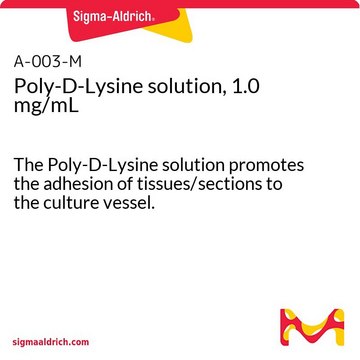P5899
Poly-ʟ-Lysine Hydrobromide
synthetic, mol wt ≥300,000, powder, γ-irradiated, suitable for cell culture, BioXtra
Sinónimos:
PDL HBr
About This Item
Productos recomendados
product name
Poli-L-lisina hydrobromide, mol wt ≥300,000, lyophilized powder, γ-irradiated, BioXtra, suitable for cell culture
origen biológico
synthetic (organic)
Nivel de calidad
esterilidad
γ-irradiated
Línea del producto
BioXtra
formulario
lyophilized powder
mol peso
≥300,000
envase
pkg of 5 mg
técnicas
cell culture | mammalian: suitable
cobertura de la superficie
4 μg/cm2
impurezas
<10% water (by Karl Fischer)
solubilidad
H2O: soluble 50 mg/mL, clear to very slightly hazy, colorless to faintly yellow
Condiciones de envío
ambient
temp. de almacenamiento
−20°C
cadena SMILES
Cl.NCCCCC(N)C(O)=O
InChI
1S/C18H38N6O4/c19-10-4-1-7-13(22)16(25)23-14(8-2-5-11-20)17(26)24-15(18(27)28)9-3-6-12-21/h13-15H,1-12,19-22H2,(H,23,25)(H,24,26)(H,27,28)/t13-,14-,15-/m0/s1
Clave InChI
WBSCNDJQPKSPII-KKUMJFAQSA-N
¿Está buscando productos similares? Visita Guía de comparación de productos
Aplicación
- 2-well plates before seeding muscle cells in a research study on rainbow trout myotube formation
- flat bottom 96-well plates for in vitro neuronal stem cell differentiation
- T75 flasks for primary astrocytic cultures
Acciones bioquímicas o fisiológicas
Componentes
Precaución
Nota de análisis
Otras notas
Código de clase de almacenamiento
11 - Combustible Solids
Clase de riesgo para el agua (WGK)
WGK 3
Punto de inflamabilidad (°F)
Not applicable
Punto de inflamabilidad (°C)
Not applicable
Equipo de protección personal
Eyeshields, Gloves, type N95 (US)
Certificados de análisis (COA)
Busque Certificados de análisis (COA) introduciendo el número de lote del producto. Los números de lote se encuentran en la etiqueta del producto después de las palabras «Lot» o «Batch»
¿Ya tiene este producto?
Encuentre la documentación para los productos que ha comprado recientemente en la Biblioteca de documentos.
Los clientes también vieron
Artículos
Poly-Lysine enhances electrostatic interaction between negatively-charged ions of the cell membrane and positively-charged surface ions of attachment factors on the culture surface. When adsorbed to the culture surface, it increases the number of positively-charged sites available for cell binding.
Cancer stem cell media, spheroid plates and cancer stem cell markers to culture and characterize CSC populations.
Extracellular matrix proteins such as laminin, collagen, and fibronectin can be used as cell attachment substrates in cell culture.
Protocolos
Poly-L-Lysine Cell Attachment Protocol
Nuestro equipo de científicos tiene experiencia en todas las áreas de investigación: Ciencias de la vida, Ciencia de los materiales, Síntesis química, Cromatografía, Analítica y muchas otras.
Póngase en contacto con el Servicio técnico









